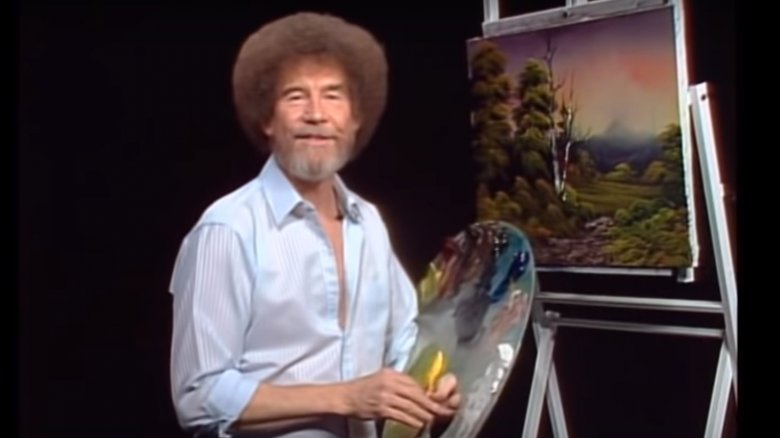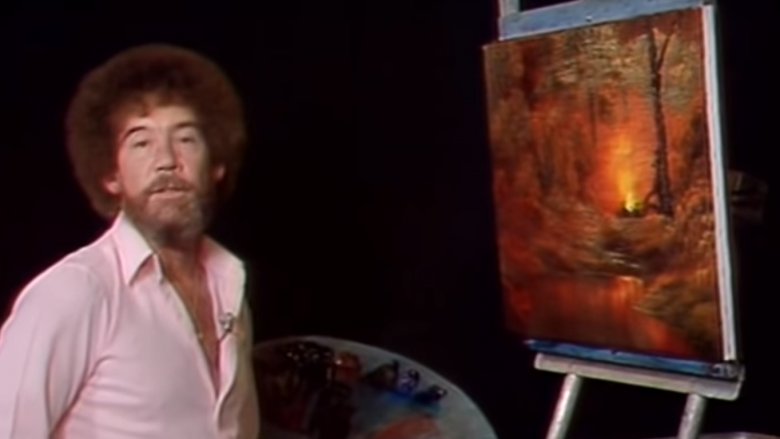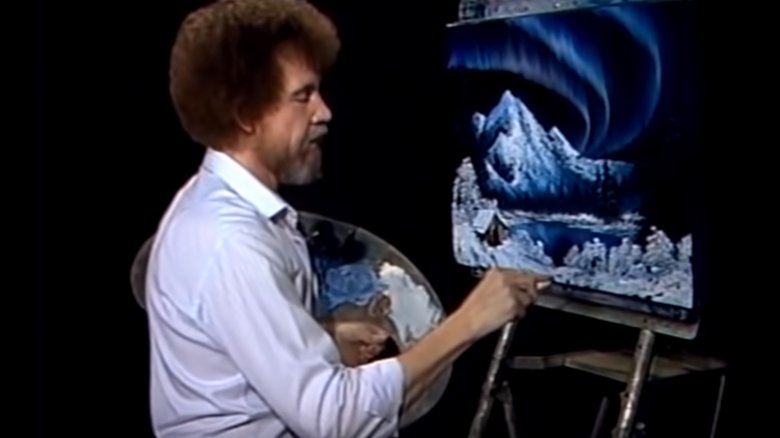The Most Impressive Bob Ross Paintings And Episodes
Bob Ross, the very permed and oft-bespectacled star of PBS' long-running and beloved The Joy of Painting, is many things to many people. His stated mission was to take the mystery out of an intimidating and inaccessible art form so amateur painters might experience the happiness and pride that comes in creating a masterpiece. And thanks to the miracle of television, Ross' audience could create such masterpieces from the comfort of their own living rooms.
Over the span of 31 seasons of the show, Bob Ross obviously ended up accomplishing much more. Thanks to his famously chill style, his generosity with compliments and pep talks, and his fearlessness in the face of "happy accidents," Bob Ross garnered a legion of fans, many of whom were content just to watch him cover paintings in majestic mountains and happy trees and babbling brooks, regardless of whether they went to the trouble of actually painting anything themselves.
He also pioneered a style of painting that rejected avant garde aesthetics in favor of the splendors of nature and the peace one finds by ditching the rat race for a walk in the woods or a stroll by a pond on a snowy evening. Given the breadth of Bob Ross' work, it's tough to pick the best episodes, but here are a few highlights from a stunning and far-reaching career.
The "Happy Accidents" of Bob Ross
In the last episode of Season 11 of The Joy of Painting, Bob Ross begins the show in a unique way — with what looks like a completed work. He usually starts off with a blank canvas, but the purpose of this particular installment, aptly titled "Happy Accident," is to help viewers overcome an especially vexing problem in painting: What to do when you've made an obvious error or when the painting itself is just fatally flawed.
In the previous decade of the show, Bob Ross had already made a name for himself for taking what appeared to be complete paintings and adding black slashes right down the center. Of course, the slashes are soon trees that viewers have to admit make the perfect finishing touch on the piece. "Happy Accident," though, is that surprise maneuver on speed. He takes his palette knife in hand and begins to strip paint from the canvas, to, in other words, take that perfectly fine painting and destroy it. Then he paints another scene in its place.
The re-do is a gorgeous creek scape, complete with eddies and rapids so vivid you can almost hear the water babbling. Perhaps even more important than the finished product is the message Ross leaves you with at the end of the episode: No painting is a lost cause, and do-overs are just fine, in art and in life.
Keep those home fires burning, Bob Ross
Bob Ross is most known for his paintings of mountain landscapes, happy trees, and waterfalls, but he also paints one hell of a campfire. In Episode 10 of Season 3 of The Joy of Painting, Bob Ross begins with a canvas covered in one of his signature colors, Alizarin Crimson. Then, with a one-inch brush dipped in Cadmium Yellow, he begins to create the outlines of a fire using X-shaped strokes. He makes the fire's heart a brilliant yellow and its ridges a darker red, blending and blending and offering this invaluable piece of advice: "You don't want to bring a dirty brush back to the center." That would muddy the color. (You also don't want to bring a paint brush to a palette knife fight, but that's a subject for another day.)
By the time Bob Ross is finished with his campfire, it's surrounded with luminous shrubs and a pond that reflects the fire's golden glow. He can't resist, of course, grabbing some Van Dyke Brown and adding a big, strong tree in the foreground because, as he confidently announces, "trees are the most fantastic things in nature." Perhaps most alarming to many fans will be the man Ross sketches in at the end. Human forms don't often make an appearance in Bob Ross paintings, but someone had to start that fire, right? And the man looks completely natural with his back up against a tree trunk, and, as Ross puts it, "his foots next to the fire."
The sky's the limit for Bob Ross
As often as Bob Ross focused on earthbound things like trees, rivers, and mountains, he was just as excited to turn his attention to the heavens. In the "Northern Lights" episode of The Joy of Painting, Ross looks upward, and the painting he produces over the course of the show rivals the awe-inspiring spectacle that is the aurora borealis.
Bob Ross, a Florida native, joined the Air Force when he was 18 years old and was stationed at Alaska's Eielson Air Force Base. He was not happy in the military — and he decided after he got out to never raise his voice to another person again — but loved Alaska's untamed beauty, which he honors in this episode.
He begins with a dark canvas coated in black acrylic, Phthalo Blue and Green, and Alizarin Crimson. He then sketches in three bright arcs with a fan brush coated in Titanium White and pulls the paint up with a 1-inch brush. The technique brings out the colors already on the canvas and soon Ross has recreated a scene he was lucky enough to witness over and over again in the roughly dozen years he spent in America's 49th state. He's also included a looming mountain, crashing waves, and a rugged cabin ready for human habitation.
As Ross puts it halfway through the show, "God was really having a good day when he made Alaska." And God must have had a blast when he made Bob Ross.
Bob Ross goes south (in a good way)
In the "Tropical Seascape" episode — Season 12, Episode 9 for those of you keeping score — Bob Ross ventures out of his comfort zone, i.e. majestic mountain landscapes and soothing wooden scenes, and into the tropics, proving that Paul Gauguin did not have exclusive rights to the sandy beach.
To help him keep a firm eye on the horizon, Ross starts off his seascape by dividing the canvas with masking tape. Then he starts with the top half, using a mixture of yellows and reds and blues to create a pastel sunset befitting paradise. Later, he focuses on the sea itself, creating impossibly perfect waves that crest just so under a nodding palm. His technique for making waves is simple — he draws an outline of a wave first, uses a 2-inch brush to fill in the color down below, and then highlights each tiny peak using his palette knife, upon which he's rolled a mix of bright color. Ross makes it look easy, of course, but then again, he's making wave noises as he works, and he probably hasn't been at the tiki bar all day.
As is the case with many of his shows, Ross decided to devote the episode to the beauty of the beach to satisfy his viewers. They wanted him to go south, and he selflessly answered the call.
Do go chasing waterfalls
It only makes sense, really, that the champion of painting-as-meditation would take on something as soothing as waterfalls. One of his best contributions to the genre is "Misty Waterfall" from Season 7, and we're not just saying that because he starts with a canvas that is, in his words, "wet, slick, and ready to go." The greatest appeal of this episode just might be how well it showcases the Bob Ross philosophy of painting.
While he dots a blue sky with happy little clouds and lines the horizon with trees (also happy and little), Ross quotes his uncle, who once said, "If you want to catch a rabbit, you can go stand behind a tree and make a noise like a carrot." And, Ross adds, that's what you have to when attempting to give life to a glen. "You got to think like a tree." And to make a good waterfall, you have to "think like water." He also advises his viewers to watch for mistakes that end up being assets. Happy accidents, in other words.
The mist over the waterfall comes courtesy of pulling down on the edge of shrub-like trees, which Bob Ross blends together with soft but confident strokes. Incidentally, Ross' casual demeanor was, according to his good friend and business manager, very much an act. He was, in fact, meticulous and exacting in his approach, creating three separate paintings for each episode and agonizing over every word, too.
Bob Ross, mountain man
In some ways, Bob Ross was like the U.S. Postal Service of mountains: He painted them in rain and heat and snow and gloom of night. He liked to claim that his son, Steve, painted better mountains than he did, but just watch Season 6's "Arctic Beauty" and it's clear that no one could make a mountain quite like Bob Ross.
Ross understood that mountains presented many challenges to his inexperienced viewers. How do you invest a 2-D mountain with the proper majesty? And how do you give your painting proper perspective so the mountains don't take over the entire composition?
These are questions he answers in "Arctic Beauty," by starting with a black canvas and painting in the sky first. When he does get around to adding the mountains, he uses his tried and true technique of rolling a mix of paints onto his palette knife and unrolling that mix right onto the canvas. Bam — mountains. As with Ross' ponds and cabins and trees and waves, his mountains look effortless. They're also breathtaking and realistic and only part of a much larger composition that includes a meadow and a cascading stream.
In this episode, Ross invites his audience to go wild with their mountains, adding whatever detail makes them happy, but he also advises they use the right tool for the job: "It's almost unbelievable what you can create with just a big old knife."
Home is where the heart is
There are a million ways to begin an episode of a painting show, and Bob Ross, for all his cozy predictability, was not averse to taking chances. In "Trapper's Cabin," Episode 8 of Season 29 (yeah, 29), Ross chose to open with a shot of him cradling two baby birds in his hands. He informs the audience that the birds are week-old swifts that have just gotten their feathers. Then he tenderly transfers them to a nest set up next to his easel and starts painting.
There are also a million ways to paint a house, and Bob Ross was famous for being able to paint a cabin in just a few strokes. In this show, having filled in a beautiful and layered background of mountains, meadow, and lake, and having made friends with a number of happy little trees — "We're artists," he says. "We're allowed to do things like that" — he goes to work on an outbuilding for the ages.
For cabins, Ross often employed the same knife he used for his mountains. This episode is no exception. He rolls some browns and whites up on the knife and, with a feather-light touch, unfurls the cabin's weathered walls and roof. Then he adds some red to the roof, inviting his fans to "get crazy. Really crazy."
Like "adopting little birds and having them watch you paint" crazy? Why not.
50 shades of gray
Fans often wrote to Ross or approached him in public, asking him to create certain scenes or make use of particular techniques so that they might be able to do the same at home. In Season 2, Episode 4, of The Joy of Painting, Bob Ross goes above and beyond, painting a wintry scene in whites and grays to show a colorblind viewer that a person's ability — or inability — to see color need not determine their destiny as a painter.
We should say straight away, that Ross is showing a decent amount of chest in this episode and that he's also wearing bling, a gold medallion of some sort. So that's delightful. Now onto the painting itself: Bob mixes up some blue and brown to make the gray. The only other color he allows himself to use in this show is white. Boring, right? Wrong.
With gray on his brush, he swirls in some clouds, blends them, and then moves on to a range of mountains. He gives the mountains some company in the form of happy trees, a misty stream, and a small, pleasantly weathered house. The theme of this episode is "almighty." Ross paints in "almighty mountains" and an "almighty river" and "almighty trees," all the while reinforcing the idea that everyone has estimable talents, regardless of whether they see the entire rainbow.
All in the family
In the final episode of the first season of The Joy of Painting, Bob Ross invited his son, Steve, to come on the show and ask him a series of questions fans had sent in during that inaugural year. The first star of the show is Bob's beard: It's '80s shaggy and magnificent. Second billing goes to his and Steve's matching glasses: gold frames, progression lenses, they're dork dad meets pimp daddy. And last but definitely not least, we must give props to Steve, who looks to be about 15 or 16 and more than a little reluctant to serve as his father's guinea pig/prop/pride and joy.
The questions Steve poses for his father are part of the lasting charm of this episode. The very first is, "What is Magic White?" It's actually a very thin, white, oil-based paint that stays wet on the canvas for extended periods of time. Other questions involve how to choose the best brushes (go natural bristle, not nylon), whether it's okay to wash brushes in turpentine (definitely not), and if it's kosher to use canvas boards instead of acrylic canvas (again, no). All great, nitty-gritty advice for any aspiring Ross acolyte.
The painting Ross creates during this episode is beautiful, too — it's a mountain scene with woods in the foreground — but the real draw is watching the Ross father-son bond play out in real time.
The dark and the light
Bob Ross was a very private public person. He shared much with his fans over the years but kept careful guard over his personal life and, for the most part, stayed out of the spotlight. Fans knew from what intimate information he shared in episodes of The Joy of Painting that he lived in Alaska for a time, served in the military, adopted a number of orphaned animals, and had a son named Steve. But what they might not have realized is that he was struggling with the illness of his second wife during the show's 23rd season, and that he likely filmed this episode, "Mountain Ridge Lake," shortly after her diagnosis.
Ross often said that one rule of painting is that you can't have the light without the dark. Very yin-yang, of course, but also incredibly poignant in this episode when it appears Bob Ross is channeling his grief and putting his heart right on the canvas. Putting aside his trademark self-deprecation — "Let's just do something easy" — the resulting painting is a stunning summer scene of soaring mountains and a gorgeous, reflective lake inviting you to jump in it, swim, stay a while.
The most heart-breaking and telling line of the entire segment is when Ross indirectly addresses his heartbreak, assuring viewers that "there will always be good times that follow the bad." Then he adds, "I'm waiting on the good times now."
Can happy trees cry? Asking for a friend.
Bob Ross' beginner's luck
It would be difficult to overstate the joy that is the very first episode of The Joy of Painting, which debuted on PBS on January 11, 1983. It's sweet, it's beautiful, it's awkward, and it's inspiring. It's titled "A Walk in the Woods," and it's Bob Ross doing what he does best: giving aspiring painters all the tools they need to create "almighty pitchers." Okay, "pictures," but who cares? It's Bob Ross' world now and we're just living in it.
In that world, one uses natural bristle brushes, almighty palette knives, and an assortment of just eight colors, including Prussian Blue, Van Dyke Brown, and Dark Sienna. Already, Ross is demystifying the process. He wants his viewers to see that everyone has a painter hidden inside of them. The trick is to draw that painter out.
The painting itself is one of his fuzzier efforts. The trees are golden and bushy, the bushes are nebulous and pink-tinged. At the center is a narrow path winding out of sight and in the foreground is a series of descending puddles because, "maybe, just maybe, it rained last."
And maybe, just maybe, a perfect show was born, the kind of show that would inspire and comfort and delight audiences for generations.


